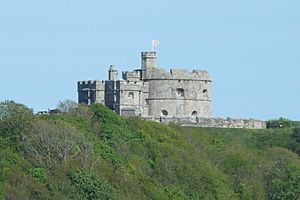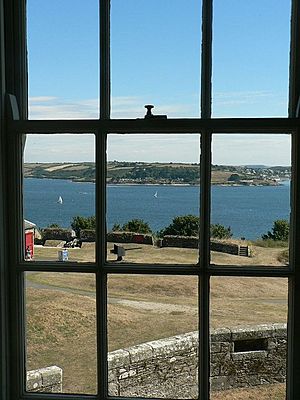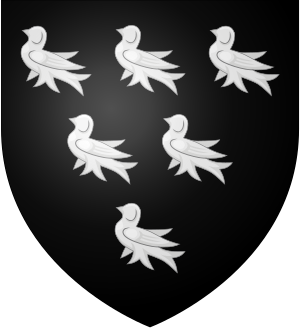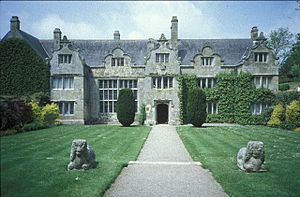John Arundell (born 1576) facts for kids
John Arundell (born 1576 – died December 1654) was an important figure from Cornwall, England. He came from a very old family in the area. During the Civil War, he was a strong supporter of King Charles I. He was even nicknamed "Jack for the King" because of his loyalty. John Arundell became the Governor of Pendennis Castle in Falmouth, a key fortress.
In 1646, he bravely defended Pendennis Castle during a long, five-month siege by the Parliamentarian army led by Fairfax. His soldiers faced extreme hunger, even eating their horses to survive. Despite the hardship, he eventually surrendered with honor. John Arundell also served as a Member of Parliament (MP) for Cornwall twice (1601 and 1621). He also represented smaller towns like Tregony (1628), Mitchell (1597), and St Mawes (1624).
His family, known as "Arundell of Trerice," should not be confused with another famous Cornish family, the "Arundells of Lanherne." Even though they shared the same swallow symbol on their coats of arms, they likely had different origins.
Contents
Early Life and Family
John Arundell was born in 1576. He was the oldest son of John Arundell (who died in 1580). His father was also a Member of Parliament for Mitchell and the Sheriff of Cornwall. His father was also responsible for rebuilding the main family home, Trerice House, around 1572.
John's mother was Gertrude Denys. Her family was also well-known. John also had a younger brother, Thomas, who was a soldier. His grandfather was Sir John Arundell (1495–1561), known as "Jack of Tilbury". He was a trusted helper to King Henry VIII and served as the Vice-Admiral of the West. He was knighted in 1513 and was also the Sheriff of Cornwall twice.
Political and Military Career


In 1597, John Arundell began his political career as a Member of Parliament for Mitchell. He later became an MP for the important county of Cornwall in 1601 and 1621. He was also the Sheriff of Cornwall in 1607. He continued to serve as an MP for St Mawes in 1624 and for Tregony in 1628. His time in Parliament ended in 1629 when King Charles I decided to rule without Parliament for eleven years.
When the English Civil War began, John Arundell remained loyal to King Charles I. He was a Royalist. In 1643, he was present at the Royalist victory at the Battle of Braddock Down in Cornwall. Around the same time, he was made governor of the royal Pendennis Castle. This castle was built by King Henry VIII to protect Falmouth Harbour.
After the Royalists lost the Battle of Naseby in 1645, the Parliamentarian army moved into the West Country. General Fairfax demanded that Arundell surrender Pendennis Castle. John Arundell bravely refused, saying he would rather "bury myself" than give up the castle to those fighting against the King.
He held out for five months in a very difficult siege. His soldiers became so hungry they had to eat their horses. Finally, in August 1646, he surrendered. Pendennis Castle was one of the very last places to hold out for the King. After the war, when the Commonwealth government was set up, he was fined a large sum of money. Although his lands were taken for a while, he was eventually able to get them back.
Marriage and Children
John Arundell married Mary Cary. She was the daughter of George Cary, who was the Sheriff of Devon. John and Mary had several children, including:
- John Arundell (1613–1644): He was the eldest son and also an MP. Sadly, he was killed during the Siege of Plymouth in 1644.
- Richard Arundell (1616–1687): He was the second son. After the King returned to power, Richard was given the title of Baron Arundell of Trerice. This was partly to reward his father's loyalty and brave defense of Pendennis Castle. Richard also served as an MP before he became a Baron.
- Nicholas Arundell (1623–1666): He was the third son and also an MP for Truro.
Death and Legacy
John Arundell died in December 1654. Since his eldest son, John, had died during the war, his lands were inherited by his second son, Richard.
Six years after John Arundell's death, the monarchy was restored in England. King Charles II rewarded Richard, John's son, by making him Baron Arundell of Trerice. This honor was given partly because of John Arundell's loyal service and heroic actions for the Crown.
In Books
John Arundell is a character in the historical novel The Grove of Eagles by Winston Graham. The book shows him in a positive light.
See also
- Arundell family



